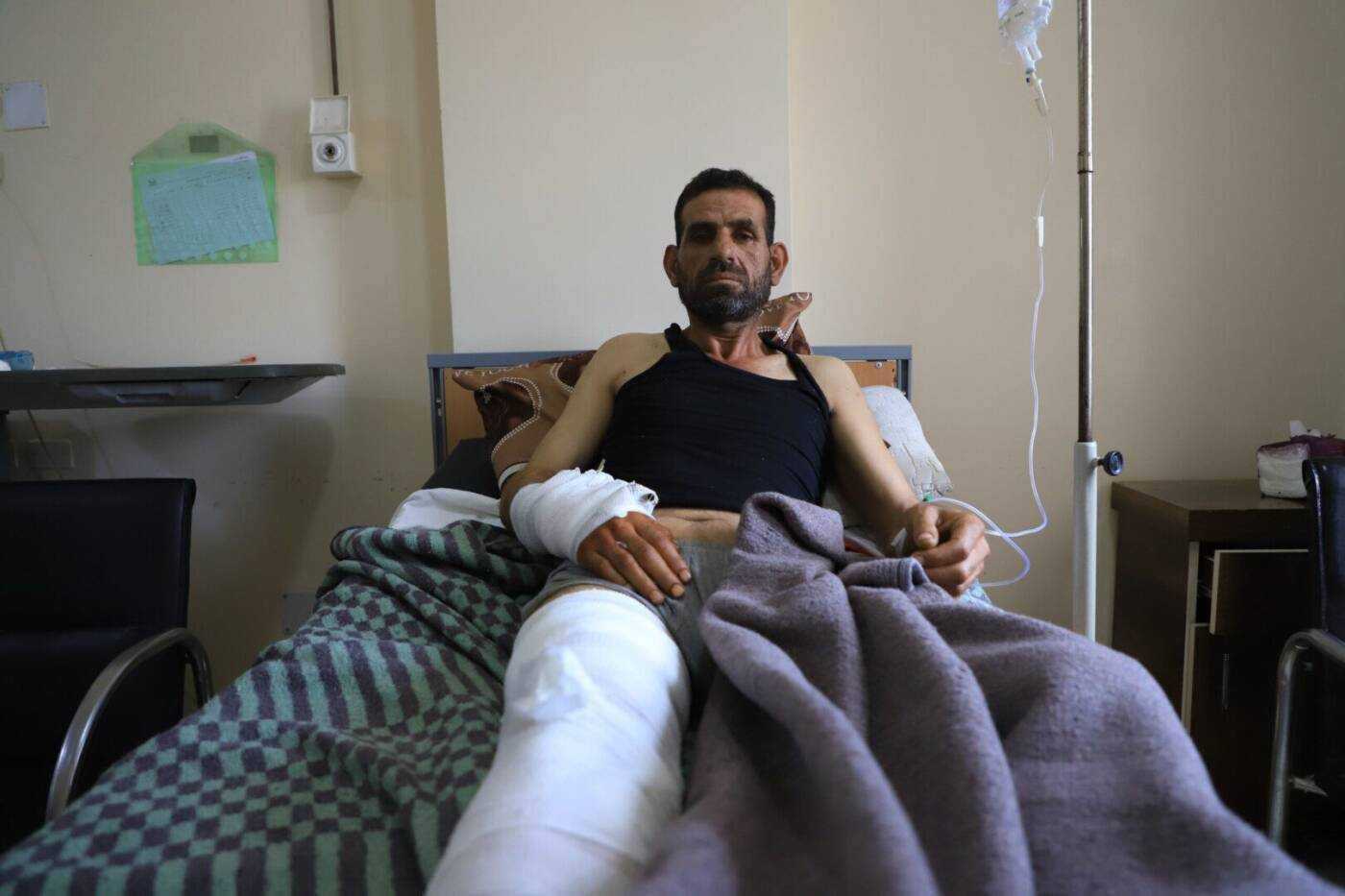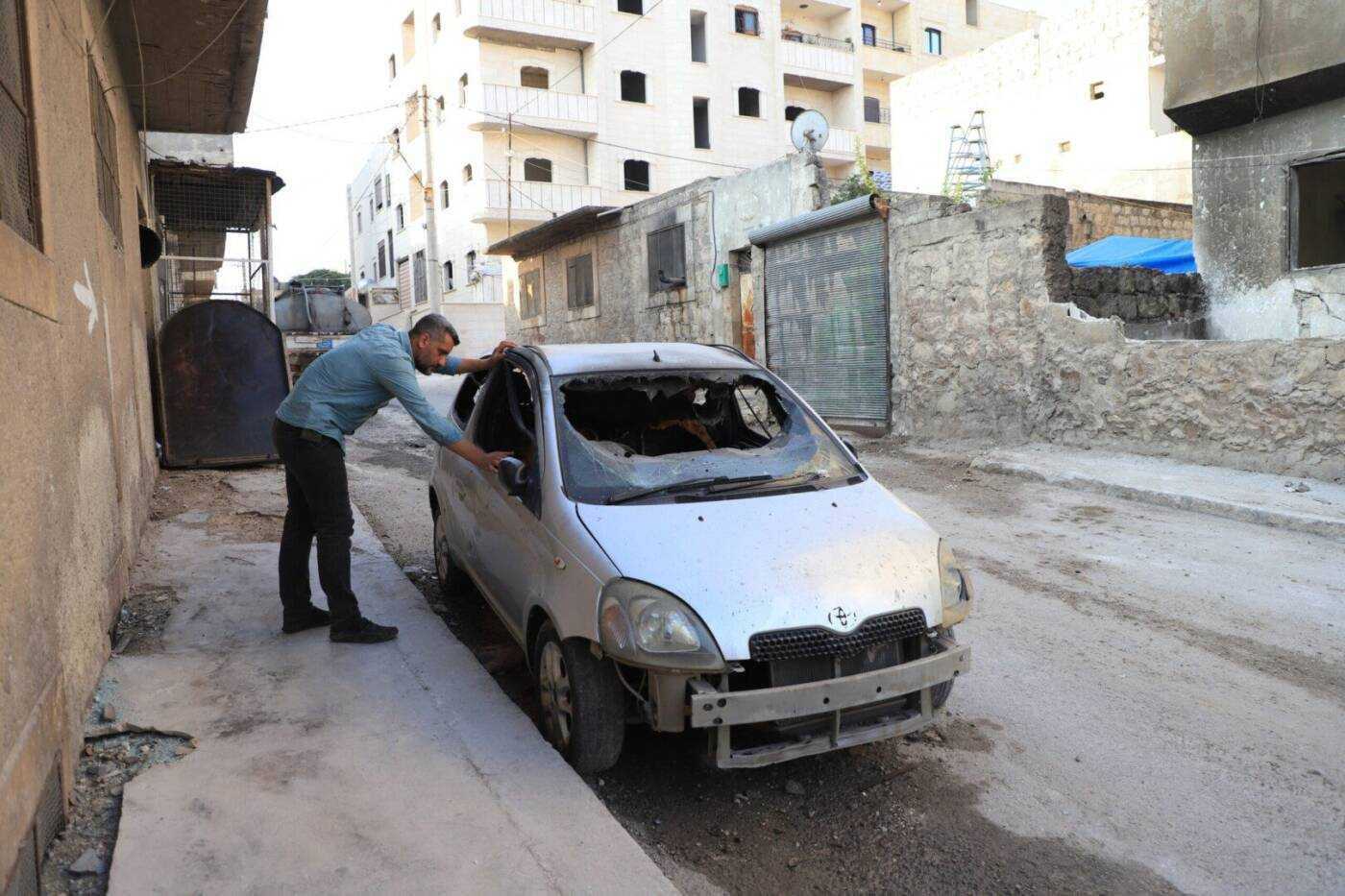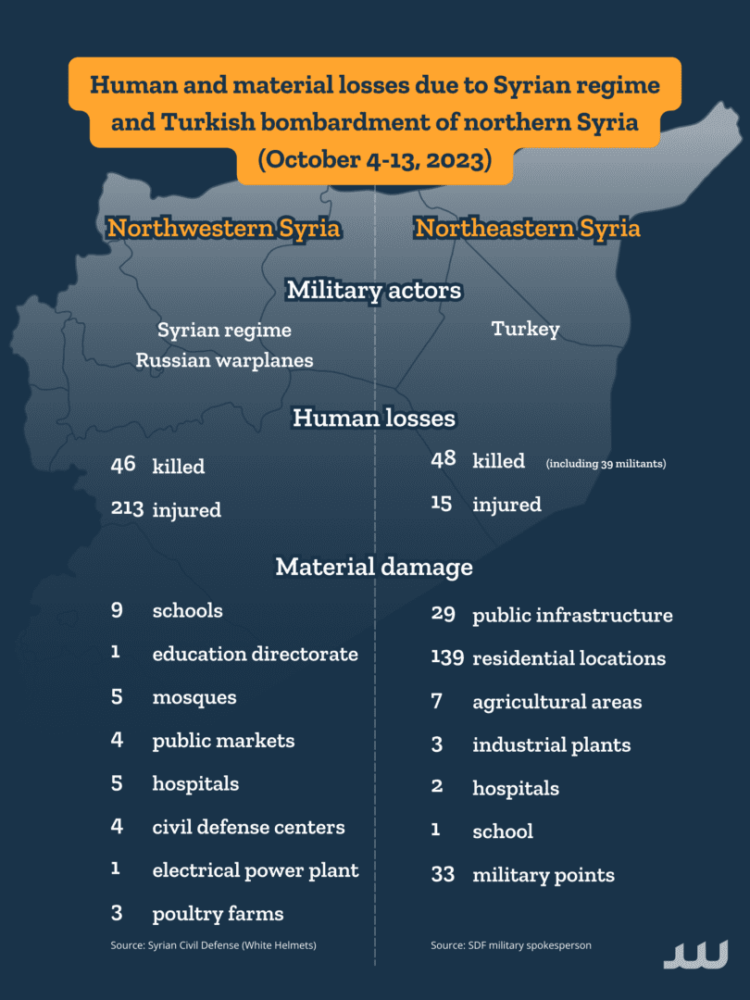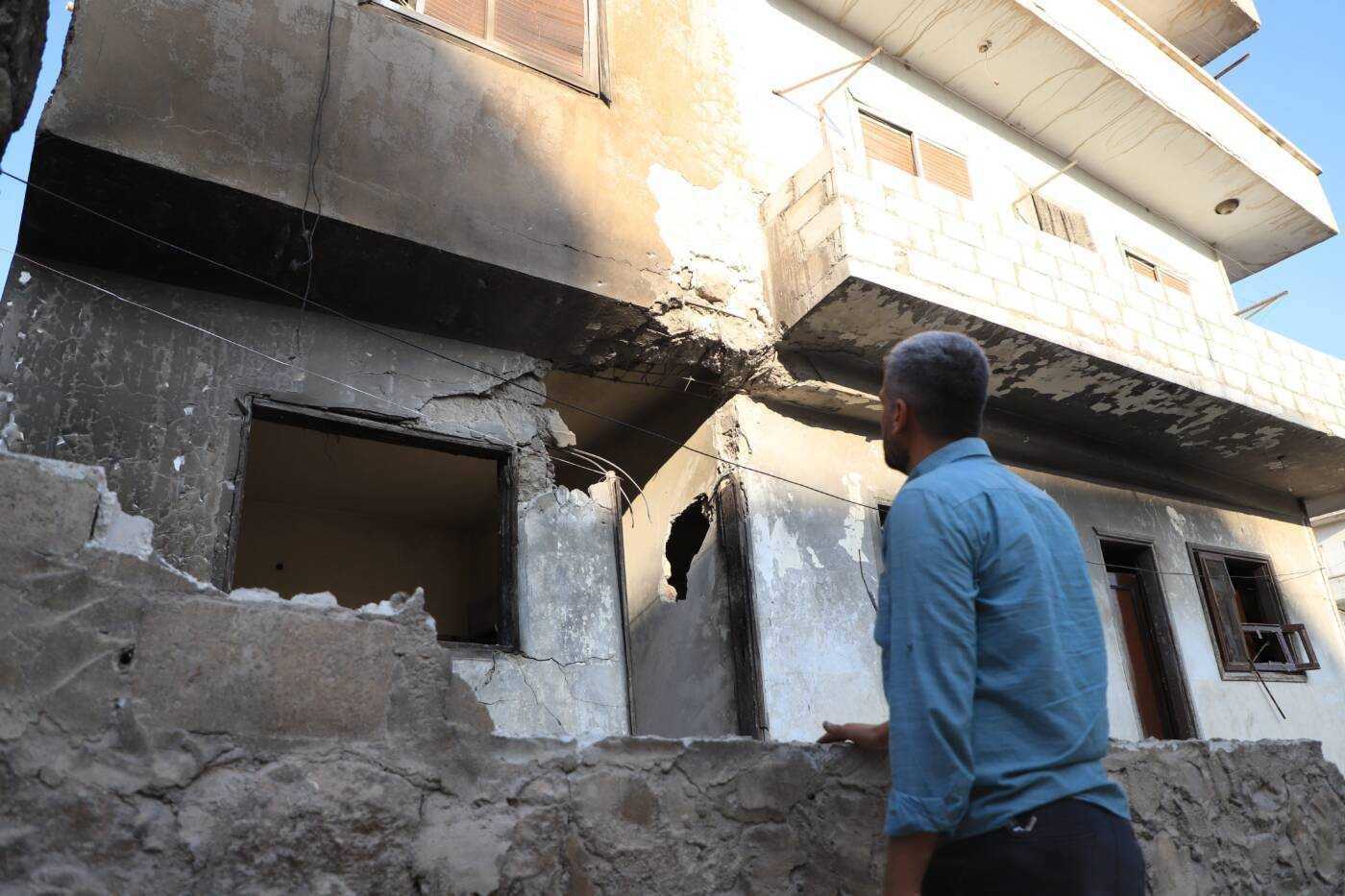‘We pay the price for their conflict’: Civilians across northern Syria under Damascus and Ankara’s bombs
Bombings across northern Syria this month—by the Syrian regime and Russia against the HTS-controlled northwest, and by Turkey in the SDF-controlled northeast—have something in common: killing civilians and damaging infrastructure.
13 October 2023
PARIS/IDLIB — Nadim Barhoum al-Omar considers it a miracle that his family survived the shelling of their home, in the northern district of Idlib city, by regime forces on October 7.
“We woke to the sound of an explosion,” al-Omar, 42, told Syria Direct. It was 7:30 in the morning. “At first, we didn’t understand what happened. Then we saw fire burning in the house, thick dust everywhere.” He remembers “how the building shook from the shelling, and the panic of my wife and children.”
Al-Omar’s family made it out, but others were not so lucky. Across opposition-held northwestern Syria, at least 46 civilians were killed in the first nine days of an ongoing campaign of regime and Russian bombardment this month.
Two days earlier, and hundreds of kilometers to the east, Muhammad al-Aleiwi, a doctor of traditional Arab medicine, was killed when Turkish forces shelled oil facilities near his home in the countryside of al-Qahtaniya, a town in Syria’s northeastern Hasakah province.
The bombardment—part of a military operation by Ankara against the Syrian Democratic Forces (SDF) and Kurdistan Workers’ Party (PKK) in Iraq and Syria—also injured members of al-Aleiwi’s family.
Turkey’s operation began at the start of October, after the General Security Directorate of Ankara’s Ministry of Interior was targeted by a suicide bomb attack on October 1. The PKK later claimed responsibility for the assault, in which two Turkish police officers were injured. Ankara views the SDF as an extension of the PKK, which is listed as a terrorist organization by Turkey and the United States.
The Syrian regime’s ongoing bombardment of Hay’at Tahrir al-Sham (HTS) held parts of northwestern Syria, meanwhile, began on October 5, after a drone attack during the graduation ceremony at the Homs Military Academy killed at least 89 people and injured 277 others. No group has claimed responsibility for the bombing.
Despite the different actors and adversaries involved in bombings across northern Syria this month—whether by the Syrian regime and Russia in the HTS-controlled northwest, or Turkey in the SDF-controlled northeast—the two escalations have something in common: the targeting of civilians and damage to infrastructure.
As of October 13, regime and Russian bombardment had killed 46 civilians in Syria’s northwestern Idlib province, and injured 213 others, Munir al-Mustafa, the deputy director of the Syrian Civil Defense, told Syria Direct. Two members of the civil defense were among the wounded.
In the northeast, Turkish bombardment killed nine civilians and injured 15 this month, among them four children and three women, Mahmoud Habib, the spokesperson for the SDF’s Northern Democratic Brigade, told Syria Direct. Some 39 members of the SDF and other armed groups were also killed, he said.
Northwestern Syria
The shelling of al-Omar’s home in Idlib destroyed walls and damaged windows, doors and floors, leaving it “uninhabitable,” he said. As a result, his family fled to the farms surrounding Idlib city. Life has turned to chaos, “after we were living in calm,” al-Omar said, referring to the relative stability in HTS-held areas since the March 2020 ceasefire deal between Ankara and Moscow.
The same day al-Omar’s house was bombed, Anwar al-Deek, 48, was at work, filling water tanker trucks in southern Idlib’s Ariha city, when a shell fell 10 meters away. Shrapnel from the explosion injured him and two other workers.
“When the shell landed on the asphalt, there was a red flame, then the place was filled with black smoke. I felt as though somebody hit my hands and feet with a 200-kilogram hammer,” said al-Deek, a father of five displaced to Ariha from Muhambal village in 2019. “I couldn’t feel my limbs, as if I was paralyzed.” Lying in this state, he heard somebody near him calling out “my foot, my foot.”
Al-Deek struggled to his feet, trying to stand and move away from the bomb site. But “after a few steps, I fell to the ground, and stayed there until people came to take me to the hospital,” he said.

Anwar al-Deek, 48, lies in his bed at Idlib University Hospital after he was injured by regime shelling of the Idlib countryside city of Ariha on October 7, 10/10/2023 (Abd Almajed Alkarh/Syria Direct)
Since the Homs Military Academy bombing on October 5, HTS-controlled areas of northwestern Syria—in Idlib province and parts of Aleppo and Latakia—have been bombarded daily by Syrian regime forces and Russian warplanes. Damascus accuses HTS and opposition factions in Idlib of carrying out the attack.
Northeastern Syria
Unlike previous rounds of Turkish bombardment in northeastern Syria, this month’s attacks largely focused on infrastructure—electricity and water plants and grain silos, alongside oil facilities and SDF military and security headquarters, two sources there told Syria Direct.
They noted that Ankara’s bombings markedly decreased in the second half of last week. That corresponds with Turkish President Recep Tayyip Erdoğan’s statement on October 9, in which he said his country had concluded the first phase of its operations in Syria and Iraq “successfully.” He said airstrikes and artillery fire destroyed 194 targets and killed 162 “terrorists,” as he described them.
On the ground, the picture was different. “Within a minute and a half, Turkish planes burned four oil sites in al-Qahtaniya, killed Muhammad al-Aleiwi and injured members of his family,” al-Aleiwi’s relative Abu Uday told Syria Direct. “It was a large explosion, and each raid was followed by another just 17 seconds later,” he said. “Surveillance cameras around my house documented the moments of the bombing.”
In Amuda, a northern Hasakah city on the Turkish border, Ankara’s warplanes bombed electricity and water stations, a textile factory and grain silos in the first days of the operation, Qassem Adnan (a pseudonym), 63, told Syria Direct from his home there. Military and security points were also hit, he said.
Grain silos around 400 meters from Adnan’s house were bombed twice, “causing panic and displacing people in the neighborhood,” he said. “In the five-story building I live in, everyone fled after the first strike. Only my family and I are left.” He refused to leave, he said, “even if the Turks reached my front door.”
In al-Qahtaniya, al-Aleiwi’s family fled to surrounding farmland after the bombing that killed him. They returned home on October 10, after Erdoğan announced the end of the operation’s first phase. Coming back does not mean the surviving relatives are not afraid of bombardment, which “could start again, but we can’t stay in the farmland,” Abu Uday said.
Electricity has been cut in al-Qahtaniya for more than a week, Abu Uday said. The local electricity company provided the neighborhood he lives in with a generator to replace one destroyed by Turkish planes on October 9, but “less than 24 hours later, the power supply was cut, and is still cut, due to the lack of fuel needed to operate it,” he said.
Amuda is also without electricity, and no drinking water can be pumped, due to “the destruction of the pumping stations and a lack of fuel,” Adnan said.
Damaged services are impacting “economic activity, which is paralyzed,” Adnan said. “People are trying to save their money, buying only necessities in anticipation of the worst.”

Nadim Barhoum al-Omar’s car was damaged when regime shelling struck his residence in Idlib city on October 7, 11/10/2023 (Abd Almajed Alkarh/Syria Direct)
Hurling accusations
The basis of Turkey’s bombardment of northeastern Syria this month was its claim that those who carried out the Ankara attack infiltrated its territory from SDF-controlled parts of Syria.
“There are many weaknesses in the Turkish narrative,” Northern Democratic Brigade spokesperson Habib said, calling claims of infiltration from northeastern Syria “accusations invoked as a pretext to start the attack.”
“It is impossible for people carrying weapons and explosives to move from our areas towards Turkey. The border strip is reinforced with a separation barrier equipped with surveillance points and thermal cameras. Anyone who approaches is shot,” he added.
Habib said the latest Turkish escalation “broke ceasefire agreements signed in 2019 with the United States of America and Russia,” and that US-led coalition forces should have intervened “to stop this heinous crime.”
In response, Turkish foreign policy and security analyst Omer Ozkizilcik said his country’s forces “target the financial resources of the People’s Protection Units [YPG, which make up the bulk of the SDF], and are trying to reduce its financial system in Syria.” Oil facilities were targeted because “around 75 percent of the budget of the so-called [SDF-backed] Autonomous Administration in North and East Syria comes from oil revenues.”
Ozkilcik compared Turkey’s strategy to that used by the US-led coalition to dry up Islamic State (IS) resources during battles against the extremist group. He expected “Turkish airstrikes and drone strikes to continue, but at a decreased frequency.”
In northwestern Syria, Jalaluddin al-Hamawi, an HTS military commander, said “accusing Idlib of the military academy bombing is a justification for a hysterical regime campaign against cities and villages, aimed at keeping its support base on alert and making it believe it is in danger.”
Al-Hamawi echoed unproven theories circulating in the wake of the October 5 drone attack that Damascus fabricated the bombing to “distract loyalists’ attention from the major problems they are suffering, after Assad sold all Syria’s capabilities and wealth to the occupiers,” referring to Iran and Russia.
“The al-Fatah al-Mubin operations room [a military formation that includes HTS] has started to respond directly and with force to the sources of fire, and has been able to destroy most of them,” he said.

Infographic: Human and material losses due to Syrian regime and Turkish bombardment of northern Syria, October 4-13, 2023 (Syria Direct)
‘We pay the price for their conflict’
In northwestern Syria, Russian and regime bombardment this month targeted: nine schools, Idlib’s Education Directorate, five mosques, four public parkets, five hospitals, four civil defense centers, a power plant and three poultry farms, according to al-Mustafa of the Syrian Civil Defense.
Meanwhile, in the northeast, Turkey targeted “around 55 facilities, ranging from oil, gas and electricity stations to ovens and institutions, in an attempt to strike and destroy the possibility of living in these areas,” the Syrian Observatory for Human Rights (SOHR) wrote on October 12.
According to SDF figures, the northeast was hit by around 288 strikes, including 207 with artillery and heavy weapons, 25 airstrikes and 56 drone strikes, Habib said.
In a video recording sent from his residence in Amuda, Adnan laid blame with those who “carried out the Ankara operation and implicated us in this war.” He said “people are not pleased with this operation, and curse both sides. We are all victims in this conflict between the PKK and Turkey.”
In al-Qahtaniya, Abu Uday felt similarly. “Civilians are the victims of the conflict between all parties in Syria. We pay the price for their conflict.” His relative al-Aleiwi “was a peaceful, upstanding man,” he said. “He didn’t get involved in the war, but he paid the price.”
Northern Democratic Forces spokesperson Habib rejected the portrayal of the SDF as a party to the harm inflicted on the lives of civilian residents.
Many civilians in northwestern Syria feel similarly to their neighbors in the northeast. “If one of them fires a bullet at the regime, it responds by bombing civilians. What happened at the military academy is not our fault,” al-Deek said from his hospital bed. “Are civilians the ones who fire missiles? Do my children and I have missiles and drones, for us to be struck?”
“When I heard the news about the military academy being targeted, I knew the regime would target us in Idlib,” al-Deek said. “I took my children to the basement, warned them not to go out, and went to work.”
In Idlib, this month’s escalation has not been limited to targeted bombardment, a fact reflected in the higher number of civilian victims than in the northeast. Several cities and towns in northwestern Syria “have been virtually depopulated after the latest escalation, including Jisr al-Shughour, Ariha, Majdaliya and Mazabour,” Mustafa of the Syrian Civil Defense said.
“Alongside missile attacks and thousands of shells, the regime carried out four attacks with incendiary phosphorus munitions, one cluster munitions attack and six airstrikes.”
**
This report was originally published in Arabic and translated into English by Mateo Nelson.







